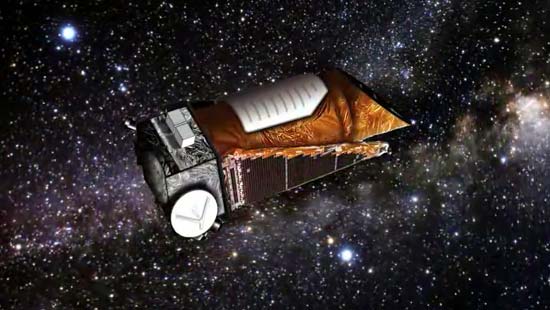
NASA's Kepler space telescope has resumed its search for alien planets after resting for 10 days to work out kinks in its attitude control system, mission officials announced today (Jan. 29).
Kepler went into a protective "safe mode" on Jan. 17 after engineers detected elevated friction levels in one of its reaction wheels — devices that maintain the observatory's position in space. Engineers spun the wheels down to zero speed, hoping the break would redistribute lubricant and bring the friction back down to normal.
That phase is now over and Kepler is back in action, though it will take time to determine if the problem is solved.
Kepler began coming out of safe mode at 2:30 p.m. EST (1930 GMT) Sunday (Jan. 27) and started collecting science data again at 8 p.m. EST Monday (Jan. 28; 0100 GMT Jan. 29), officials wrote in a mission update today. [Gallery: A World of Kepler Planets]
"The spacecraft responded well to commands and transitioned from thruster control to reaction wheel control as planned," Kepler mission manager Roger Hunter wrote in the update. "During the 10-day resting safe mode, daily health and status checks with the spacecraft using NASA's Deep Space Network were normal."
Kepler flags exoplanets by detecting the telltale brightness dips caused when they pass in front of their parent stars from the instrument's perpsective. The telescope requires three functioning reaction wheels to stay locked onto its roughly 150,000 target stars.
When Kepler launched in March 2009, it had four reaction wheels — three for immediate use, and one spare. But one wheel (known as number two) failed in July 2012, so a major problem with the currently glitchy wheel (called number four) could spell the end of the $600 million Kepler mission.
Breaking space news, the latest updates on rocket launches, skywatching events and more!
It's unknown at the moment if the 10-day rest period will bring wheel number four back into line.
"Over the next month, the engineering team will review the performance of reaction wheel #4 before, during and after the safe mode to determine the efficacy of the rest operation," Hunter wrote.
The wheel has acted up before without causing serious problems.
"Reaction wheel #4 has been something of a free spirit since launch, with a variety of friction signatures, none of which look like reaction wheel #2, and all of which disappeared on their own after a time," Hunter wrote.
To date, Kepler has discovered more than 2,700 exoplanet candidates. While just 105 of them have been confirmed by follow-up observations so far, mission scientists estimate that more than 90 percent of them will end up being the real deal.
Follow SPACE.com senior writer Mike Wall on Twitter @michaeldwall or SPACE.com @Spacedotcom. We're also on Facebook and Google+.

Join our Space Forums to keep talking space on the latest missions, night sky and more! And if you have a news tip, correction or comment, let us know at: community@space.com.

Michael Wall is a Senior Space Writer with Space.com and joined the team in 2010. He primarily covers exoplanets, spaceflight and military space, but has been known to dabble in the space art beat. His book about the search for alien life, "Out There," was published on Nov. 13, 2018. Before becoming a science writer, Michael worked as a herpetologist and wildlife biologist. He has a Ph.D. in evolutionary biology from the University of Sydney, Australia, a bachelor's degree from the University of Arizona, and a graduate certificate in science writing from the University of California, Santa Cruz. To find out what his latest project is, you can follow Michael on Twitter.
